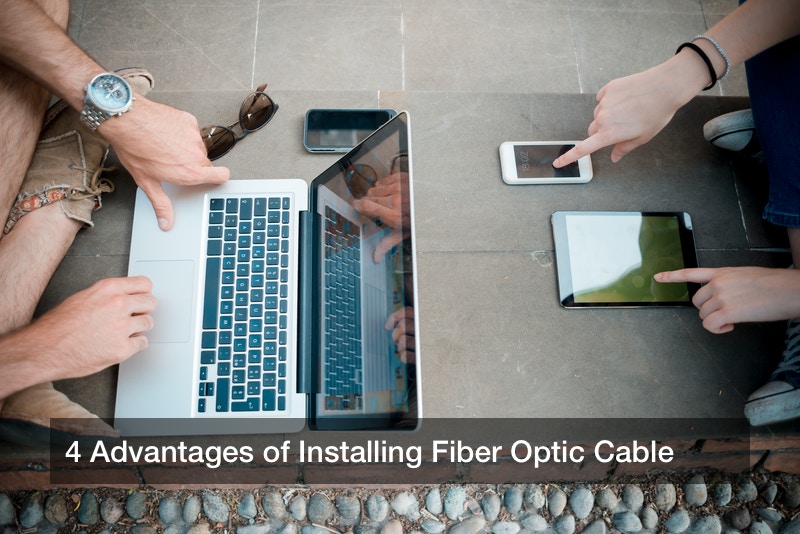

UPDATED 6/12/2020
People use many types of cables throughout a typical day. Whether using cell phone cables for a mobile device or USB cables for a project, people love staying connected. And whether you like it or not, cables allow us to do many of the things we take completely for granted. Television, internet, smartphones, and all manner of other things rely on the functionality of cables. They keep us connected to one another and to the world.
Another popular way for people to stay connected is through the use of fiber optic cables. Whether you’re installing fiber optic cable in cold weather or you’re simply reaping the benefits of this innovation, fiber optic cables are an important connector in our world today. The first fiber optic cables were used to connect the United States and France to Britain during 1988. Just think about the cable installation temperature and cable flexibility tests they had to run. Since this time, fiber optic cables have increased in popularity. Now people are installing fiber optic cable in cold weather and asking for more cable wire installation services than ever before. And Statistics gathered from March 2017 found that there were 3.74 billion people using the internet. Considering that, many of these people prefer to find companies offering fiber optic internet service. With that in mind, here are four advantages of choosing fiber optic cables.
Offering More Bandwidth

Many people choose fiber optic cables due to their immense bandwidth capabilities. Bandwidth is a term meaning the maximum data transfer rate. If you’re dealing with something like Cat 5 cables, the Cat 5 heat rating could negatively affect your data transfer speed. And if you’re suffering from limited bandwidth, many online activities become difficult. One of the best things about fiber optic cables is just how much speed they actually offer. The immense amount of bandwidth offered by fiber optic cables ensures smooth connections every time.
Extremely Fast Data Transfer Speeds
It’s understandable to see bulk fiber optic cables and wonder how these items received their name. One reason for this could be that these cables use light to transmit data. In turn, this allows fiber optic cables to send data at extremely fast speeds. This goes hand in hand with bandwidth when we’re talking about cables. Low temperature wires like fiber optics are particularly effective when high data transfer speeds are necessary.
Less Weather Sensitivity

Certain types of cables might experience problems due to weather conditions. For instance, certain cable materials can freeze during extremely cold weather. In addition, moisture is also known to cause damage to many types of cables. But can fiber optic cable freeze? Does cold weather affect fiber optic cable at all? Fortunately, you won’t have to worry about cold temperature cable problems with fiber optic seals and cables. You can have bulk fiber optic cables in many locations without worry about weather damage. Whether you’re worried about installing fiber optic cable in cold weather or the rainy climate you live in, you should be covered with fiber optics. Fiber doesn’t carry an electric current, meaning you won’t have to worry about EMI.
Ability to Carry Signals Further
Another important concern is being able to utilize cables that carry signals long distances. In turn, this could save time and money without having to install as many bulk fiber optic cables. Certain fiber optic cables are able to carry signals that reach nearly 25 miles. So before you catch yourself asking what is the temperature rating of thhn wire, it might be more worth your while to look into fiber optic cable instead. Not only is it sturdy, it really is the biggest bang for your buck. Therefore, many companies find that choosing fiber optics cable is an extremely cost-efficient option.
To summarize, there are several advantages of using fiber optic cables over worrying about cold weather ethernet cable issues. Fiber optic cables ensure that you’re able to utilize large amounts of bandwidth and fast transfer speeds. That being said, certain businesses might need a large amount of these types of cables. With that in mind, you’ll want to find a bulk fiber optic cable supplier. In turn, your business can receive all necessary cables in a fast and efficient manner.
Related: aerial fiber optic cable installation, fiber optic cable installation guidelines, fiber optic cable protection tube, fiber optic cable requirements, fiber optic cable temperature range, fiber optic underground installation, how deep does fiber optic cables buried, how to splice fiber optic cable pdf, basic construction of fiber optics, can a fiber optic cable be bent any direction, can fibre optic cable be joined using a connector block, cat 6 cable temperature rating, cold weather wire, commscope fiber optic, commscope fiber optic cable specifications, does cold weather affect fiber optic cable, fiber cable installation guide, fiber optic cable handling precautions, fiber optic cable installation services, fiber optic cable laying equipment, fiber optic documentation.
Related Keywords: aerial fiber optic cable installation, fiber optic cable installation guidelines, fiber optic cable protection tube, fiber optic cable requirements, fiber optic cable temperature range, fiber optic underground installation, how deep does fiber optic cables buried, how to splice fiber optic cable pdf, basic construction of fiber optics, can a fiber optic cable be bent any direction, can fibre optic cable be joined using a connector block, cat 6 cable temperature rating, cold weather wire, commscope fiber optic, commscope fiber optic cable specifications, does cold weather affect fiber optic cable, fiber cable installation guide, fiber optic cable handling precautions, fiber optic cable installation services, fiber optic cable laying equipment, fiber optic documentation.